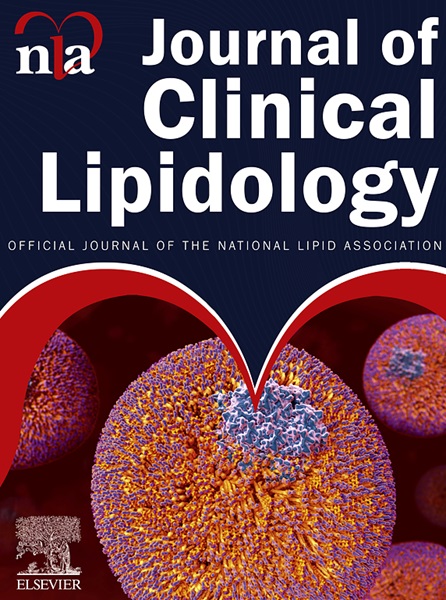对 sitosterolemia、其同类和高脂血症患者的血浆植物甾醇进行评估。
IF 3.6
3区 医学
Q2 PHARMACOLOGY & PHARMACY
引用次数: 0
摘要
背景:ABCG5/8突变的坐骨神经油血症患者通常表现为早发或快速进展性动脉粥样硬化。ABCG5/8部分遗传缺陷的家族成员通常被认为是健康的。方法:在此,我们回顾性地招募了 7 个家族,包括 8 个被诊断为坐骨神经胆固醇血症的个体,以及 14 个携带单基因突变的家族。此外,17 名高脂血症患者和 130 名健康对照者分别作为阳性和阴性对照。在上述四个组别中,总共有 6 种植物甾醇与胆固醇吸收指数(包括谷甾醇、坎贝酯醇、豆甾醇和胆甾醇)和胆固醇合成标志物(去甲胆固醇和 7-脱氢胆固醇)进行了比较:结果:不出所料,双重突变的 sitosterolemia 受试者的 sitosterol 水平和其他胆固醇吸收指标明显升高。与此同时,单基因突变的西托脂醇血症患者的胆固醇活化吸收能力与高脂血症组相似,但没有双基因突变组高。值得注意的是,胆固醇合成酶 7-脱氢胆固醇还原酶在高脂血症组中增加,但在 sitosterolemia 样本组中减少,这表明 7-脱氢胆固醇在区分这两个组别方面具有潜在的鉴别作用。在诊断坐骨神经胆固醇血症时,植物固醇组合比临床血脂指数更有价值:结论:我们的研究发现,单一基因突变的坐骨神经胆固醇血症患者的胆固醇吸收能力受到轻微干扰。此外,6 种植物甾醇的组合被证明能有效区分 sitosterolemia、其单一突变携带者和高脂血症患者。本文章由计算机程序翻译,如有差异,请以英文原文为准。
Evaluation of plasma phytosterols in sitosterolemia, their kindreds and hyperlipidemia subjects
BACKGROUND
Patients suffering from sitosterolemia with ABCG5/8 mutation typically present with early-onset or rapidly progressive atherosclerosis. Their kindreds with partial genetic deficiencies of ABCG5/8 are often considered healthy. However, discerning sitosterolemia from its familial kindreds and hyperlipidemia subjects has remained challenging.
METHODS
Here we retrospectively recruited 7 families including 8 individuals diagnosed with sitosterolemia subjects, and 14 kindreds carrying single gene mutations. Additionally, 17 individuals with hyperlipidemia and 130 healthy controls served as positive and negative controls, respectively. A total of 6 phytosterols combined with cholesterol absorption indices (including sitosterol, campesterol, stigmasterol, and cholestanol) and cholesterol synthesis markers (desmosterol and 7-dehydrocholesterol), was compared across the aforementioned 4 groups.
RESULTS
As expected, the sitosterolemia subjects with double mutations demonstrated significantly elevated levels of sitosterol and other cholesterol absorption indices. Meanwhile, sitosterolemia kindreds with single gene mutation showed a similar pattern of activated cholesterol-absorption ability to the hyperlipidemia group, but not as high as the double mutation group. Notably, the cholesterol-synthesis enzyme 7-dehydrocholesterol reductase displayed an increase in the hyperlipidemia group but a decrease in the sitosterolemia kindred group, suggesting a potential discriminative role of 7-dehydrocholesterol in distinguishing between these 2 groups. The combination of phytosterols was more valuable than clinical lipid index for sitosterolemia diagnosis.
CONCLUSION
Our study revealed mild disruptions of cholesterol absorption capacities in sitosterolemia kindreds with single mutations. Furthermore, the combination of 6 phytosterols proved effective in distinguishing between sitosterolemia, its single mutation carriers, and hyperlipidemia patients.
求助全文
通过发布文献求助,成功后即可免费获取论文全文。
去求助
来源期刊
CiteScore
7.00
自引率
6.80%
发文量
209
审稿时长
49 days
期刊介绍:
Because the scope of clinical lipidology is broad, the topics addressed by the Journal are equally diverse. Typical articles explore lipidology as it is practiced in the treatment setting, recent developments in pharmacological research, reports of treatment and trials, case studies, the impact of lifestyle modification, and similar academic material of interest to the practitioner.
Sections of Journal of clinical lipidology will address pioneering studies and the clinicians who conduct them, case studies, ethical standards and conduct, professional guidance such as ATP and NCEP, editorial commentary, letters from readers, National Lipid Association (NLA) news and upcoming event information, as well as abstracts from the NLA annual scientific sessions and the scientific forums held by its chapters, when appropriate.

 求助内容:
求助内容: 应助结果提醒方式:
应助结果提醒方式:


